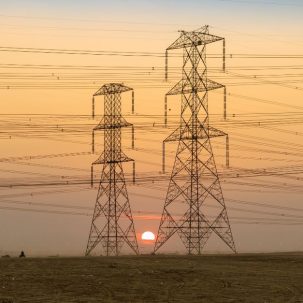Across the European Union (EU), energy flexibility is starting to grow in power systems, encouraged by upcoming decarbonisation deadlines and the network code on demand response. Here’s an overview of some of the trends in 2025 affecting how flexibility markets are developing in the EU.
This blog covers:
- Market-based flexibility is becoming an economic need as grid costs grow
- Day-ahead trading shifts to 15-minute intervals, boosting system flexibility
- ACER publishes its flexibility assessment methodology and call to action
- The new Network Code on Demand Response progresses
- EU flexibility markets evolve: From cross-border projects to national platforms
- Barriers to flex market implementation remain
- Supporting mechanisms like non-firm connections advance
1. Market-based flexibility is becoming an economic need as grid costs grow
EU flexibility markets are becoming an economic necessity. With an estimated €730 billion needed for distribution and €477 billion for transmission grid upgrades by 2040, relying on grid expansion alone is proving unsustainable. The European energy regulator ACER warns that network costs could rise 20 – 40% by 2030, and potentially double by 2050, with serious risks for electricity affordability.
Market-based flexibility offers a cost-effective alternative. ENTSO-E estimates that tapping flexibility potential could save up to €5 billion annually in generation costs. In many cases, boosting the capacity of existing networks through demand response, storage, and distributed generation is cheaper and faster than building new power lines.
This indicates an opportunity to place EU flexibility markets at the centre of Europe’s strategy to contain grid costs while accelerating the energy transition – and changes are already on the horizon.
2. Day-ahead trading shifts to 15-minute intervals, boosting system flexibility
The EU’s day-ahead market has now shifted to 15-minute trading windows, a change that gives the power system a much sharper view of what’s happening in real time. With prices updating four times as often, short swings in renewable output or local demand become visible rather than lost inside hourly averages. That makes it far easier for solar, wind, storage and other flexible assets to respond at the right moment and be rewarded for it.
For system operators, the move strengthens operational stability by tightening the link between near-term forecasts and dispatch decisions. For market participants, it means more opportunities to trade around genuine system conditions rather than broad estimates. The effect is a more dynamic market architecture that values responsiveness.
3. ACER publishes its flexibility assessment methodology and urgent call to action
In July 2025, the Agency for the Cooperation of Energy Regulators (ACER) approved a common EU methodology for assessing non-fossil flexibility needs. Member states must carry out national flexibility assessments by July 2026 and use them to set indicative flexibility targets by January 2027. This is a crucial step to align national policies with Europe’s decarbonisation goals.
That’s the long-term goal. Yet, for the short term, ACER has also set out 12 “no-regret” recommended actions to accelerate demand response. These include stronger price signals through dynamic and time-of-use tariffs, simplified market entry for aggregators and small players, and wider rollout of smart meters.
If policymakers, system operators, and flexibility providers act now, this will remove barriers and scale up participation to tap into the benefits of flexibility.
4. The Network Code on Demand Response progresses
In March 2025, ACER submitted its proposal for a new EU-wide Network Code on Demand Response to the European Commission. This code will establish the rules that allow consumers, storage providers, and distributed generation to participate directly in wholesale electricity markets. Implementation is expected from 2027.
The code complements the flexibility assessment methodology as mentioned above. While the methodology will help define what flexibility is needed, the Network Code provides the framework for delivering it. Together, they create a foundation for EU flexibility markets to grow rapidly over the next decade.
5. EU flexibility markets evolve: From cross-border projects to national platforms
The Netherlands: GOPACS tackles grid congestion
The Dutch GOPACS platform continues to demonstrate congestion management at scale. Over just two days in November 2024, GOPACS processed around 200 orders, enabling 2 GWh of redispatch at an average €500/MWh. This shows the platform is delivering tangible market volume and value.
Research by BCG and Ecorys warns that grid congestion could drain up to €40 billion annually from the Dutch economy, through blocked expansions, cancelled renewable projects, and lost investment. In this context, GOPACS provides a market-based solution that helps manage grid constraints cost-effectively.
Belgium: A national flexibility roadmap
Belgium’s Adequacy and Flexibility Study 2026–2036, published in June 2025, highlights significant opportunities. With enablers such as real-time pricing and digital tools, flexibility could deliver €350 – 500 million in annual system savings by 2036, while also lowering consumer bills.
Electrification is expected to push demand beyond available capacity from 2028 onwards. Flexibility solutions will therefore be central to Belgium’s energy security, supporting grid reinforcements.
BeFlexible: Testing flexibility solutions with cross-border collaboration
Project BeFLEXIBLE aims to enhance cooperation between DSOs and transmission system operators, to boost the flexibility in energy systems. With input from partners across seven countries – Spain, Italy, Portugal, Belgium, Germany, Sweden and Denmark – its goals range from increasing revenue opportunities for consumers to creating common data space exchange to support flexibility-centric business models with better information flows.
BeFlexible’s 2025 focus shifted to completing all demonstration phases, assessing their impact, and refining business models to ensure the scalability and replicability of flexibility solutions across European markets.
6. Barriers to flex market implementation remain
The Network Code on Demand Response will harmonise flexibility rules across the EU by 2027, yet smartEn’s 2024 Wholesale Markets Map shows that most countries are still at an early stage. Many have not yet introduced legislation to let demand bid into wholesale markets.
There are, however, encouraging signs. Belgium, France, Great Britain, and Greece already allow participation through independent aggregator frameworks, providing early models for others to follow. Some countries are moving fast with implicit flexibility through dynamic pricing: Norway leads with 93% of residential contracts on dynamic tariffs, compared with 30% in Finland.
This uneven progress highlights both the challenge and the opportunity. With the Network Code taking effect in 2027, Europe has a clear path to unlock the benefits of flexibility more widely and avoid being left behind.
7. Supporting mechanisms like non-firm connections advance
Beyond markets, supporting mechanisms are evolving. The EU Action Plan for Grids (2023) called for nations to establish frameworks for non-firm connection agreements. These allow connections that can be curtailed when the grid is constrained. This can be either a temporary measure, until reinforcement is built, or a permanent option, where new lines are not economical. More detail is expected later this year with the European Grids Package.
The UK is already moving forward with this approach, operationalising it through markets. In project BiTraDER, Electron is working with SP Electricity North West, AFRY, and LCP Delta to develop a pioneering flexibility market where participants can trade their curtailment obligations with each other. For example, a wind farm facing maintenance can profitably take curtailment obligations from a solar farm experiencing peak midday generation. This makes non-firm connections more attractive and commercially viable for asset owners.
2025 in summary
2025 is shaping up as a turning point for EU flexibility markets. Regulatory foundations are advancing, methodologies are in place, and real-world examples such as GOPACS and Belgium’s roadmap show what is possible.
Yet implementation gaps remain across most member states. With grid congestion costs escalating and renewables accelerating, the economic imperative is stronger than ever. Acting without delay, as ACER urges, will bring forward the cost savings and system benefits Europe urgently needs.




